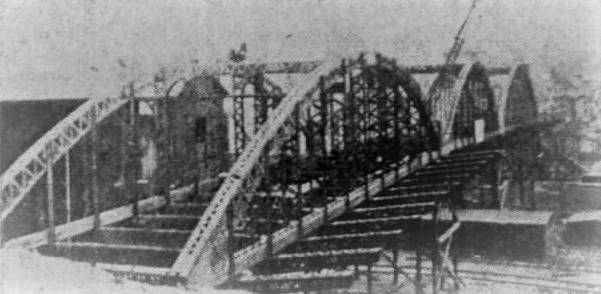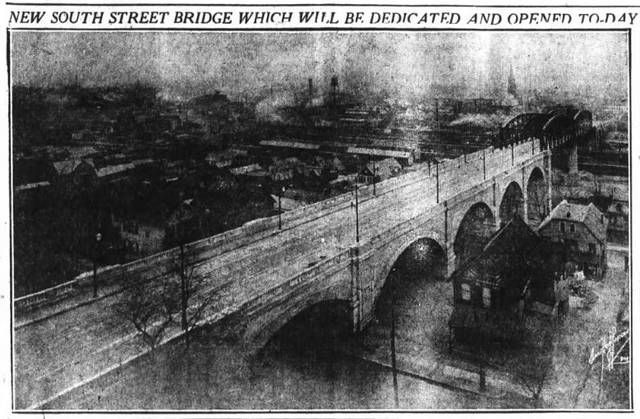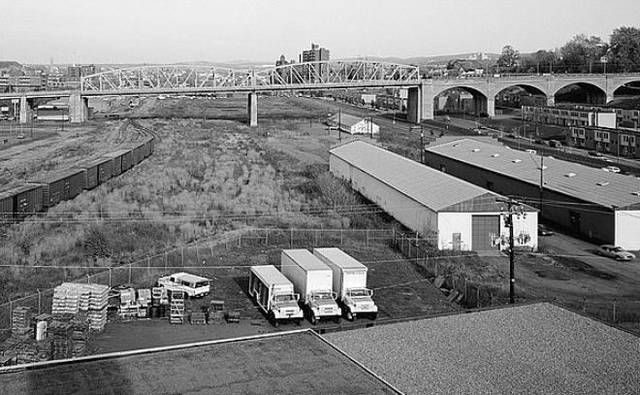
The Butler Street Viaduct is seen during construction in April 1915. Picture published in the Times Leader on Feb. 4, 1973.
File photo
Click here to subscribe today or Login.
One survived — although replaced — while the other was demolished years ago.
Rapid growth of railroad traffic with the rail yards between today’s Pennsylvania Avenue and Wilkes-Barre Boulevard caused mammoth traffic problems in central Wilkes-Barre.
Grade crossings were not possible due to continuous rail traffic arriving and leaving the Central Railroad of New Jersey and the Lehigh Valley Railroad passenger stations along with other depots in the vicinity. There were also delays of pedestrians going to and from work in central city, a matter that had been of concern to downtown employers for some time.
Something had to be done for residents to reach the Heights and East End areas of Wilkes-Barre to bypass the rail yards. The solution? Bridges.
Two spans would be built crossing over the rail yards with one at South Street to Park Avenue being first to open. Decades later, the Butler Street Viaduct would open in East End.
Efforts to build a bridge to cross the Lehigh Valley rail yard at South Street were headed by the Iron Bridge Association in late 1870.
“The South Street Bridge will be built next season,” reported the Luzerne Union newspaper Feb. 8, 1871.
On Feb. 11, 1871, the Iron Bridge Association proposed to erect at their expense a bridge over the Lehigh Valley Railroad and the North Branch Canal. In May 1871, the association proposed to extend the bridge over the Lehigh & Susquehanna Railroad provided Wilkes-Barre contributed $5,000, with a total cost to construct the bridge set at $30,000.
The South Street Bridge opened in 1873 to horse and carriage traffic. Real estate developers, notably the Lehigh & Wilkes-Barre Coal Co., took advantage by promoting “scenic views” of the Wyoming Valley in sale advertisements of property lots in the Heights.
Due to its unusual suspension form of construction, the South Street Bridge was commonly called “The Wire Bridge,” a name it was to carry for more than 40 years of service.
As vehicles became more abundant, the Wire Bridge was closed to vehicular traffic as it could not handle the weight. By the late 1910s, officials began debating to replace the Wire Bridge.
“The bridge was used to good advantage until 1910, when it began to show signs of 40 years of wear and tear. On Sept. 26, 1910, a committee was organized for building a new bridge,” reported the Wilkes-Barre Record Dec. 10, 1925.
In October 1922, the city entered an agreement with a Baltimore, Md., engineer to prepare plans and specifications for a new bridge on South Street.
The new concrete and iron truss bridge opened with a parade and a dinner at the Sterling Hotel on Dec. 10, 1925, reported the Wilkes-Barre Record the same day.
Further north in Wilkes-Barre, the same problem existed with pedestrians having a difficult time crossing the rail yard in East End.
“The railroad yards are nearly always filled with trains of coal and freight cars and to get across the tracks people climb the cars, endangering their lives constantly. Girls and women are often seen crawling under trains to save the time that would be required to go around by the safer road,” reported the Times Leader July 13, 1914.
As early as 1904, Wilkes-Barre Council set aside $31,000 as a loan to build a bridge at Butler Street but the bonds were never issued. In 1906, the question of erecting a bridge on Butler Street was taken up with the railroad companies for the first time and they agreed to pay $47,000 toward the construction cost.
The matter dragged on for eight years until a certificate was issued by the state, which divided construction cost between Wilkes-Barre, and the Lehigh Valley Railroad, Central Railroad of New Jersey and the Delaware & Hudson Railroad companies.
“Bridge over railroad yards on which the city is all but ready to start operations will connect two large sections of Wilkes-Barre with safe traffic passage. Many properties must be moved out of the way,” reported the Times Leader July 13, 1914.
The Butler Street Viaduct opened to much fanfare in September 1915. Some 25 years later, the Butler Street Bridge was rebuilt at a cost of $330,000.
Decades after the last train left the rail yards, the two bridges were seen as no longer needed as decades of weather and heavy traffic had taken their toll on the aging structures. The state Department of Transportation in the early 1980s recommended that the two bridges be demolished.
Only the Butler Street Bridge was razed, in 1985. The South Street Bridge received a $4 million face lift, reopening in November 1991.






